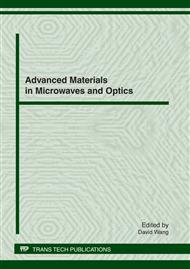[1]
R.R. Brooks, Biological methods of prospecting for minerals, New York, Wiley, (1983).
Google Scholar
[2]
E.W. Chappelle, M.S. Kim, J.E. McMurtrey, The red-edge shift: an explanation of its relationship to stress and the concentration of chlorophyll A, Geoscience and Remote Sensing Symposium, vol. 4, 1991, pp.2287-2290.
DOI: 10.1109/igarss.1991.575500
Google Scholar
[3]
W. Collins, S.H. Chang, Airborne biophysical mapping of hidden mineral deposits, Economic Geology, vol. 78, 1983, pp.737-749.
DOI: 10.2113/gsecongeo.78.4.737
Google Scholar
[4]
J.P. Darch, J. Barber, Multitemporal remote sensing of a geobotanical anomaly, Economic Geology, vol. 78, 1983, pp.770-782.
DOI: 10.2113/gsecongeo.78.4.770
Google Scholar
[5]
C.E. Dumn, Biogeochemistry in mineral exploration, Amsterdam, Elsevier Press, (2007).
Google Scholar
[6]
S.C. Dunagan, M.S. Bilmore, J.C. Varekamp, Effects of mercury on visible/NIR reflectance spectra of mustard spinach plants, Environmetanl Pollution, vol. 148, 2007, pp.301-311. doi: 10. 1016/j. envpol. 2006. 10. 023.
DOI: 10.1016/j.envpol.2006.10.023
Google Scholar
[7]
A.B. George, Quantifying chlorophylls and carotenoids at leaf and canopy scales: an evaluation of some hyperspectral approaches, Remote sensing of environment, vol. 39, 1998, p.329–335.
Google Scholar
[8]
A.F.H. Geotz, B.N. Rock, Remote sensing for exploration: an overview, Economic Geolgy, vol. 78, 1983, pp.573-590.
Google Scholar
[9]
J. E, Kester, Building good spectral vegetation backgrounds in the VNIR, Geoscience and Remote Sensing Symposium, vol. 3, 2008, pp.786-789, IEEE press, doi: 10. 1109/IGARSS. 2008. 4779466.
DOI: 10.1109/igarss.2008.4779466
Google Scholar
[10]
V.R. Lakkaraju, X.B. Zhou, M.E. Apple, et al, Study the vegetation response to simmulated leakage of sequestered CO2 using spectral vegetation indices, in press.
DOI: 10.1016/j.ecoinf.2010.05.002
Google Scholar
[11]
F. Lehmann. J. Rothfuss, R. Richter, Evaluation of imaging spectrometry data (GER) for the spectral analysis of an old vegetation covered waste deposit, Geoscience and Remote Sensing Symposium, 1990, pp.1613-1616, IEEE press.
DOI: 10.1109/igarss.1990.688817
Google Scholar
[12]
C.E. Leprieur, Red-edge measuremnt and canopy structure, a first look with AVIRIS data, Geoscience and Remote Sensing Symposium,. IEEE press, vol. 4, 1989, p.2093-(2096).
DOI: 10.1109/igarss.1989.577785
Google Scholar
[13]
H. P, Liang, X.N. Liu, Hyperspectral analysis of leaf copper accumulation in agronomic crop based on artificial neural network, 2008 international workshop on earth observation and remote sensing application, IEEE press, Nov. 2008, pp.1-6.
DOI: 10.1109/eorsa.2008.4620312
Google Scholar
[14]
H. Lin, X.Y. Liu, X.P. Xue, Correlation analysis between biogeochemical contents of camphor and in-situ hyperspectral measurement, 2008 international conference on multimedia and information technology, IEEE press, July 2008, pp.756-760.
DOI: 10.1109/mmit.2008.71
Google Scholar
[15]
F.F. Sabins, Remote sensing for mineral exploration, Ore Geology Reviews, vol. 14, 1999, pp.157-183.
DOI: 10.1016/s0169-1368(99)00007-4
Google Scholar
[16]
P. Shi, Z.Y. Wei, L. Jiang, et al, Research on tolerance of plants to heavy metal in wastelands of Fushun Hongtoushan Copper Mine, Metel mine, vol. 2, 2010, pp.155-158.
Google Scholar
[17]
V. Singhory, F. Kenny, J. Springer, Reflectance spectra of vegetation growing on mine sites in the Canadian Shield, Geoscience and Remote Sensing Symposium, vol. 2, 1989, pp.665-669, IEEE press.
DOI: 10.1109/igarss.1989.578898
Google Scholar
[18]
V. Singhory, R. Saint-Jean, J. Levesque, et al, Reflectance spectra of the boreal forest over mineralized sites, Geoscience and Remote Sensing Symposium, vol. 4, 2000, pp.1379-1381, IEEE press, doi: 10. 1109/IGARSS. 2000. 857213.
DOI: 10.1109/igarss.2000.857213
Google Scholar
[19]
K.L. Smith, M.D. Steven, J.J. Colls, Use of hyperspectral derivative ratios in the red-edge region to identify plant stress responses to gas leaks, Remote Sensing of Evironment, vol. 92, 2004, pp.207-217, doi: 10. 1016/j. rse. 2004. 06. 002.
DOI: 10.1016/j.rse.2004.06.002
Google Scholar
[20]
V.C. Vanderbilt, S.L. Ustin, J. Clark, Canopy geometry changes due to wind cause red edge spectral shift, Proceding of IGARSS, ESA SP-284, IEEE ESA Publication Division, Augest 1988, p.835.
DOI: 10.1109/igarss.1988.570451
Google Scholar
[21]
C.B. Yang, Q.G. Jiang, The study and application of mineralization information extraction by use of remote sensing in East Liaoning, Application of Remote Sensing, vol2, 2007, pp.20-24, (in Chinese with English abstract).
Google Scholar
[22]
D.L. Zhao, K.R. Reddy, V. Gopal, et al, Canopy reflectance in cotton for growth assessment and lint yield prediction, European Journal of Agronomy, vol. 26, 2007, pp.335-344.
DOI: 10.1016/j.eja.2006.12.001
Google Scholar


